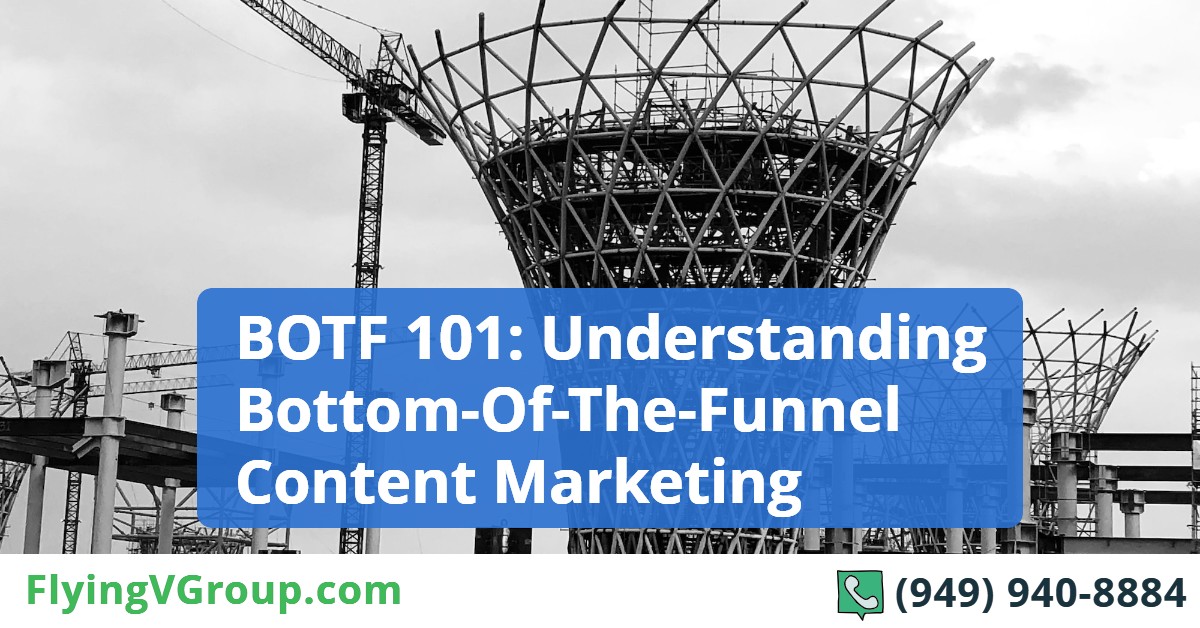A Closer Look at BOTF
To grossly oversimplify things, marketing is the process of bringing in and closing leads to generate revenue. We tend to forget about that second part. This leads marketers to create top of the funnel content that might generate interest, but not translate into the main results we care about: sales and conversions.
Where on the sales funnel should your content be? The content we create and the conversations we have are all dependent on the position of the lead in the funnel. Bottom of the funnel (BOTF) is the point where the client is close to making a decision and the marketing team usually takes their foot off the pedal. Yes, there is such a thing as overselling. But it’s important to realize that a developed BOTF content strategy can inform and reassure clients at the final stages, leading them to a purchase decision.
According to research by the CMI, only 60% of marketers produce content to nurture their leads. 47% of the content produced is geared for TOFU and only 21% of it is BOTF content: the clients most likely to make a purchase aren’t getting that extra nudge.
“When you cater to the emotional needs of your customers depending on your niche, you connect with your customers on a deeper level. With brand marketing growing more from being sales-centric to emotion-centric.” Aabhas Vijay, Founder www.SMTPServers.co
A marketer’s job is to persuade and inform leads, and BOTF content is the final frontier. Leads at the bottom of the funnel have their needs identified, have considered their options and are looking for that final something extra to get them off the fence. So what kind of content can help you?
Here’s BOTF 101. We are going to delve into BOTF content marketing and discuss what type of content works for your BOTF strategy. Let’s go!
Bottom of the funnel leads have usually been well-nurtured and have already engaged with your TOFU and mid-funnel content. Here are a few things about this lead person that you should know:
- They are interested in your product/service
- They are actively looking to close a deal and are possibly also looking at your competitors
- They know about your product/service in some detail
It is important to note that the content that they need is going to be very different from the content you use to attract lead initially or to keep them engaged. They are looking for content that will give them that final push to put pen to paper.
Often, your sales team members are actively in conversation with BOTF leads. This means that sales enablement is a key goal for your content. How do you empower your sales team with content that they can use to finally push the deal across the line? The effort you make here needs justify all the hard work that you have put in to nurture the lead through the funnel.
BOTF content isn’t just for bottom-of-the-funnel clients. When you are dealing with a significant number of leads, it is natural that some would slip through the cracks. And, of course, there will be those leads that finally just do not convert and that’s okay.
But BOTF content marketing ensures that you are leaving them with as much actionable information as possible if they want to get back to you.
What Content Works for BOTF?
We’ve talked about who BOTF content is for in this article, but what does it actually look like? These are some of your main objectives with BOTF content:
- Ensuring and clarifying the value that your product/service offers and how it works
- Accelerating the decision-making process
- Showcasing how your product is better than other options in the market for your client’s use case.
The content you are creating should align with these priorities. Remember that questions these leads have are very different from TOFU and would be very closely aligned with how the product works, instead of broad value.
Now, let’s look at a few content types that work for BOTF.
1. Customer Stories and Case Studies
There is no better way to showcase value than case studies and customer stories. Case studies showcase actual examples where you have delivered real value for your customers. It is also a great idea to include actual quotes from the customers and the end-users.
While creating these case studies, it would be a great idea to focus on some of the main metrics that the prospects can influence via your product/service. How you impacted the ROI or revenue, or customer satisfaction numbers are interesting stories. Make sure you include numbers and figures to drive home the value.
These case studies work well in a range of formats, from PDF documents and videos to infographics and more.
2. Product/Service Experience and Tutorials
It may be a great idea to let your leads experience your product or service in a controlled setup so that they can have a better understanding of how it works in the real world. It is not always possible but it is worth investing time to ideate ways of giving your clients some sort of product experience.
Tutorials are great ways to engage with leads at this stage. Take them through features and provide them guided trials to show exactly how your solution would fit into their workflow.
3. Product Comparisons and Checklists
Often, the final decision is between you and a competitor. In these cases, having content that gives users a comparative understanding of the advantages, features and benefits is a great idea.
4. Solution-Oriented Content
We use solution-oriented content for Top and Middle of the funnel stages. But with some thought, it can be used in BOTF scenarios too. How your product/service can be leveraged to solve a real problem is a great way to engage. By the time you’ve nurtured a client to the bottom of the funnel, you’ll have a good understanding of their use cases. Leverage this to create content aimed at solving thief specific problems.
5. Product and Implementation Details
When your lead is in the final decision stage, it is possible that there’s more than one decision-maker on the scene. This can complicate things, especially if that’s someone other than your champion/initial point of contact. Decisionmakers may also be thinking about implementation or other big picture delivery challenges. Sharing product and implementation details that appeal to the identified decision makers is a great way to answer these last-minute questions.
Regardless of the BOTF content you create, always ask yourself this question: Does this piece of content make a stronger case for your product? Does it compel leads to contact you and give you the green light?
Conclusion
BOTF is often a neglected area in content marketing. The flip side to this is that BOTF offers immense opportunity and a great content strategy can help clients pick your solution over the competition.
Make sure that your BOTF content is closely aligned to your product/service. It’s less about your brand and more about what your solution does. Clarify the value clients get out of it within their specific context. Go deep into your customer personas, review interview notes, and try to understand what kind of content will influence the final buying decision. BOTF is the last step: BOTF content can mean the difference between success and failure for your marketing strategy. Make the best use of it!
Looking for help with your BOTF content marketing? Flying V Group helps leading brands convert prospects into customers through intelligent content marketing strategies. Talk to us today!
Thank you so much for reading BOTF 101: Understanding Bottom-Of-The-Funnel Content Marketing. We really appreciate it! If you have any questions about our article or can suggest any other topics you think we should explore, feel free to let us know.
Be sure to sign-up for our newsletter to receive monthly emails on all of the latest trends and happenings in the digital marketing space. You will also receive our FREE E-Book with the Amazing Marketing Tools for Powerful Business Growth. Sign-up below!
Also, if you received some value out of this article, please share with your friends or colleagues, or leave a comment/question below. We really appreciate you reading our blog and every share/comment means the world to us and allows us to continue producing valuable tools to help you grow your business!






0 Comments